Sacred Ice Melting Away: Lessons from the impact of climate change on Andean cultural heritage
For many centuries, the role of mountains as custodians of the sacred ice and givers of life-sustaining water has been ritually acknowledged throughout the Andes. The religious belief in the sacredness of the Andean snowcapped peaks has led to some of the most remarkable climbing achievements in the history of humankind. These great and sacred mountains, the fascinating cultures of their inhabitants and the intrepid archaeologists and anthropologists who have explored them, hold a vast potential for educating about humans respond to long-term cultural and climactic change.
The Incas were the first humans to surpass altitudes above 20,000 feet in order to perform ceremonies involving offerings and sacrifices. The mountaintop shrines that they built on the summits of the highest volcanoes in the southern Andes are among the most interesting and less studied material evidences of their extraordinary empire (cf. Ceruti 1999, 2008). High altitude archaeology is a privileged way to combine our scientific interest in mountains and ancient civilizations in an effort to better understand the worldview of the Incas (and their descendants), while contributing to preserve their superb, but fragile summit shrines, for the generations to come.
The highest ceremonial site in the world is located over 22,000 feet, on the summit of an Andean volcano in northern Argentina. Five hundred years ago, three Inca children were sacrificed and buried on this lofty summit, to become messengers to the realms of the mountain spirits. They would intercede for the good health of the Inca Emperor and for a plentiful supply of water, to ensure the fertility of the llama herds and the abundance of the crops (Ceruti 2004; Reinhard and Ceruti 2010).
In Quechua, the language of the Incas, the name of this mountain, Llullaillaco, means “that lies about water, or hides away the water”. As a matter of fact, Llullaillaco is the only mountain in the area to have a permanent ice field on its high slopes, almost like a small hanging glacier. But the volcano gives origin to no streams or rivers that might quench the thirst of the Atacama desert at its feet. The water that melts from the icy heights is held in a hidden lagoon, above 18,000 feet (cf. Ceruti 2003; Reinhard and Ceruti 2000).
In March 1999 I was project co-director in an archaeological expedition to mount Llullaillaco, led by Johan Reinhard and funded by the National Geographic Society. The frozen bodies of the three Inca children that we eventually discovered after almost one month of archaeological fieldwork, enduring the cold and the extreme altitude of the peak, turned out to be the best preserved ice mummies in the world (cf. Ceruti 2010a; Figure 1). The sense of wonder would only grow stronger when we studied the fifteen year old Inca maiden, the seven year old boy and the six year old girl in the laboratories at Catholic University of Salta. The CT scans would reveal that all their organs, including the brains, were in a nearly perfect state of preservation after a time span of half a millennium (Previgliano et al. 2003). Isotopic analysis on hair showed significant changes in their diet during the months prior to their death (Wilson et. al 2007). The associated offerings, which included more than one hundred objects of typical Inca style, were also carefully studied (cf. Ceruti 2003; Bray et. al 2005).
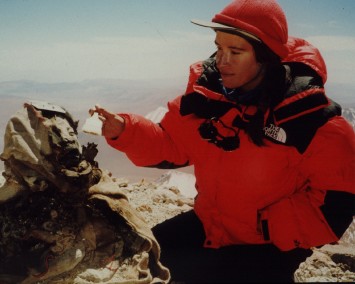
Figure 1. Constanza Ceruti discovering Inca mummy on the summit of Llullaillaco (copyright Constanza Ceruti)
Thirteen years have gone by since our discovery of the Llullaillaco ice mummies, and their presence among the living has clearly contributed to raise awareness about the urgency of preserving the cultural heritage of the Andes. Looting and plundering are among the major threats to the archaeological sites in South America, and the Inca mountaintop shrines are no exception: on a previous expedition to the 20,000 feet summit of nearby mount Quehuar, we had rescued a partly destroyed mummy bundle that had been dynamited by treasure hunters (Reinhard and Ceruti 2005).
Global warming is a somewhat more silent destroyer of the heritage of the Andes. Residents in Salta have concluded that the discovery of the Inca mummies from Llullaillaco happened just in time, before the frozen bodies of the three children might start to be affected by the progressively higher temperatures in the summertime. Not only are the archaeological evidences endangered by the impact of climate change: the cultural practices of the descendants of the Incas are also threatened. The retreating glaciers have a significant impact in the religious life of the Andes, which became clear in the field, as I was documenting a massive ceremony on the slopes of the Vilcanota Range, in the Andes of Southern Peru.
The festivity of the Star of Snow is one of the most important mountain pilgrimages in the Andean world. About 70,000 people gather at the glacier basin of Sinacara every year during the month of June (Figures 2). As a result of the syncretism with Catholicism, the festivity is nominally dedicated to the worship of an image of Christ depicted on a sacred rock, in the place where Jesus is said to have miraculously appeared to a young indigenous peasant in the eighteenth century. However, one of the main reasons why the place is recognized as sacred is that it is perceived to be under the sphere of influence of nearby Ausangate, a mountain most sacred to the ancient Incas and to the modern Quechua ritual experts, invoked during their initiation ceremonies and divination rituals.
The vast majority of devotees who visit the glacier basin during the festivity of the Lord of the Star of Snow come from the Peruvian Sierras and the Bolivian highlands, although a few of them arrive from places as distant as northern Argentina and Chile (the former territorial extension of the Inca Empire). Although some of the participants come as lay pilgrims, or even merchants, thousands of them gather as religious dancers. The dancers wear costumes that represent different ethnic groups in the Andes. The qhapaq chunchos, adorned with feathered headdresses, incarnate the indomitable Amazonian tribes of on the lower slopes of the eastern Andes; whereas the qhapaq collas impersonate the wealthy Aymara herders from the Bolivian highlands. During the five days of the festivity, at an altitude of near 17,000 feet, they dance for hours, at daytime and at night. Their impressive demonstration of physical endurance is meant to be in itself an offering to the nearby mountain spirits or Apus, especially to Apu Ausangate (cf. Ceruti 2007a and 2007b).
The place of gathering is located at the foot of a snowcapped peak called Qolque Punku, the Silver Gate. The Quechua name of the pilgrimage, Taytacha Qoyllur Ritti (Father of the Star of Snow), recognizes the crucial role of the mountain ice. As a matter of fact, the glaciers that come down from mount Qolque Punku are ritually climbed during the climax of the festivity, in search for sacred ice that is revered for its healing properties. The mission is entrusted to the young “bear-men” known as ukukus, who are perceived as mediators between the pilgrims and the mountain spirits. The ukukus are expected to climb up to the glaciers at night, braving the freezing temperatures, the crevasses, and the fear of the ghosts of the condemned souls, in order to retrieve the sacred ice that will bring health and fertility to their households (Figure 3).
Traditionally, the bear-men would extract large chunks of ice – as big as they could carry on their backs – , and return to their home communities, where the ice would be distributed among the villagers, as a powerful material symbol of the blessings from the Apu mountain spirits. However, things have started to change in the last few years, and global warming is to be blamed.
I remember seeing dozens of bear men descending the glaciers of Qolque Punku, but to my surprise, many of them were coming down the mountain empty-handed. At one time, I was delighted to notice a bear man rushing down the hill with a heavy chunk of ice on his back. Innocently, I thought that he was trying to get to his village before the ice melted on his back, until someone explained that he was running fast to avoid being stopped by the “mountain police”. That is how I learnt that extracting the sacred ice is no longer permitted: pilgrims are only allowed to collect melted ice in small water bottles that they can take home as substitute relics.
The man who was explaining the situation to me was himself an ukuku. He carried a doll, representing a miniature bear-man, on whose back he had placed a handful of ice, in the hope that he would be able to “smuggle” the sacred cargo down the mountain, without catching the attention of the policemen (Figure 4). If caught, however, he could always put the blame on the doll, as he said with a picaresque smile. With a saddened heart, I could not help but admire his firm determination to faithfully honor the ancestral traditions, in spite of adversity. But I also admire those who to carry only the water instead of the ice, in order to assist in the preservation of the glaciers.
Pilgrims, including very young children, traditionally climb up the lower sections of the glaciers in daylight, to light candles on the ice (cf. Ceruti 2010b). Bare footed, kneeling on the snow, they may pass hours watching the candles burn. Their silent prayer is combined with a careful contemplation of the flame, intended to provide them with answers to their most intimate concerns. Surely they would have preferred to use larger candles, of the kind that the Lord of the Star of Snow is said to like best. But in recent times, they are only allowed to light small candles. Sometimes they cannot complete their traditional rituals a policeman is likely to ask them to put the candles away, in a desperate attempt to stop the glaciers from retreating.
The ice of the snowcapped peaks has always been a precious source of water that makes life possible in the Andes. That simple truth has been sacred to the hearts of the Andean people, who look upon the mountains as deities. For five centuries, the highest volcanoes have been the custodians of ancient treasures offered by Inca pilgrims, including the frozen bodies of the children selected to be messengers to the mountain spirits. Today, the preservation of Andean mummies is endangered, not only by looting, but also by global warming (Reinhard y Ceruti 2006).
The descendants of the Incas still go on pilgrimage to pay homage to the mountain spirits. The sacredness of the ice is enhanced with the healing and fertilizing qualities attributed by the reverent footsteps of the brave native bear- men. However, the ancestral rituals are changing due to the retreating glaciers caused by global warming, and Quechua people are in fear that once the ice is gone, the Lord of the Star of Snow will no longer listen to their prayers.
As sad as it must be to see Andean peoples forced to change their ritual worship of their mountains, it is also remarkable to discover how understanding and accommodating they have proven to be. By avoiding the extraction of larger pieces of ice and the use of large candles in order to preserve the snow cover on the mountain, they are setting an example of selflessness and mindfulness that should be acknowledged and followed beyond the Andes.
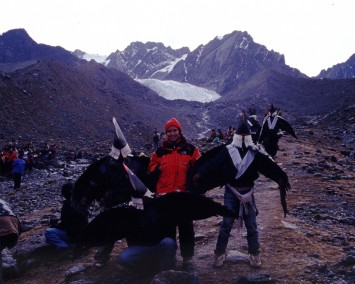
Figure 5. ConstanzaCeruti and condor-dancers representing the mountain spirits at Qoyllur Ritti (copyright Constanza Ceruti)
REFERENCES
Bray, Tamara; Leah Minc; María Constanza Ceruti; José Antonio Chávez; Ruddy Perea y Johan Reinhard
2005 A compositional analysis of pottery vessels associated with the Inca ritual of capacocha. Journal of Anthropological Archaeology 24:82-100.
Ceruti, María Constanza
1999 Cumbres Sagradas del Nororeste Argentino. EUDEBA (University of Buenos Aires). Buenos Aires.
2003 Llullaillaco: Sacrificios y Ofrendas en un Santuario Inca de Alta Montaña. EUCASA (Catholic University of Salta. Salta).
2004 Human bodies as objects of dedication at Inca mountain shrines (north-western Argentina). World Archaeology 36 (1):103-122. Oxford. UK.
2007a Realm of the Ice-cloaked Mountain Gods. En The Explorers Journal 85 (3): 36-37. New York.
2007b Qoyllur Riti: Etnografía de un peregrinaje ritual de raíz incaica por las altas montañas del sur de Perú. Scripta Ethnologica XXIX: 9-35. Centro Argentino de Etnología Americana. Buenos Aires.
2008 Panorama de los santuarios Inca de alta montaña en Argentina. Revista Arqueología y Sociedad Nº 18: 211-228. Museo de Arqueología y Antropología de la Universidad Nacional Mayor de San Marcos. Lima.
2010a Embajadores del Pasado: los niños del Llullaillaco y otras momias del mundo. EUCASA (Catholic University of Salta. Salta).
2010b The Religious Role of Children in the Andes, Past and Present. AmS Skrifter volume 23: 125 – 133. Archaeological Museum. University of Stavanger.
Previgliano, Carlos, Constanza Ceruti, Johan Reinhard, Facundo Arias Araoz y Josefina Gonzalez Diez
2003 Radiologic Evaluation of the Llullaillaco Mummies. AJR 181: 1473-1479
Reinhard, Johan y Constanza Ceruti
2000 Investigaciones arqueológicas en el volcán Llullaillaco. EUCASA (Catholic University of Salta. Salta).
2005 Rescue Archaeology of the Inca Mummy on Mount Quehuar, Argentina. Journal of Biological Research LXXX (1): 303-307. Turín.
2006 Sacred Mountains, Ceremonial Sites and Human Sacrifice Among the Incas. Archeoastronomy XIX: 1 – 43. University of Texas Press. Austin.
2010 Inca Rituals and Sacred Mountains: a study of the world´s highest archaeological sites. Cotsen Institute of Archaeology. University of California Los Angeles (UCLA).
Wilson, Andrew; Tymothy Taylor, María Constanza Ceruti, José Antonio Chávez, Johan Reinhard, Vaughan Grimes, Wolfram Meier-Augenstein, Larry Cartmell, Ben Stern, Michael Richards, Michael Worobey, Ian Barnes and Thomas Gilbert
2007 Stable isotope and DNA evidence for ritual sequences in Inca child sacrifice. PNAS (Proceedings of the National Academy of Sciences of the USA). Vol 104, Nº 42: 16456-16461.
[1] A preliminary version of this paper was published in 2007 at the fall´s issue of The Explorer´s Journal.







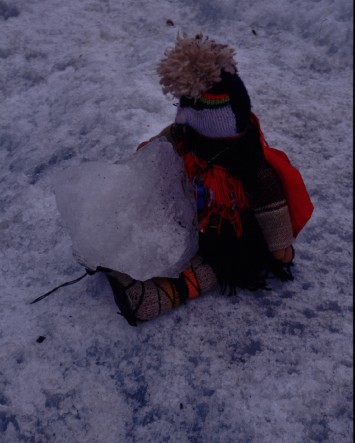
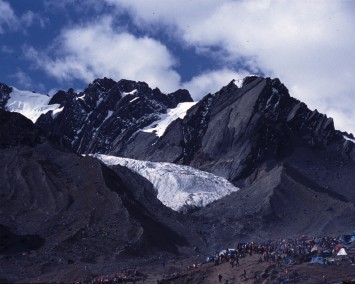
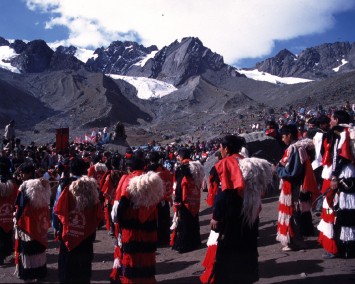





Thank you for sharing your experience in the discovery of the children mummies. I just happen to find it on this site and are amazed at just how brave the children must have been. Not only the children but how brave the parents of the children. Amazing what humans will do in the name of faith and god. It causes me to stop and reflect on my life today. How fortunate we are and how little as a society we fail to appreciate or even notice the small things in life that are right in front of us every day. Thank you again.